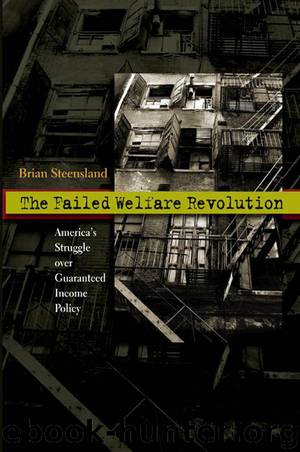The Failed Welfare Revolution by Steensland Brian;

Author:Steensland, Brian; [Steensland, Brian;]
Language: eng
Format: epub
ISBN: 9780691127149
Publisher: Princeton University Press
Published: 2008-01-15T07:00:00+00:00
The “Notch Effect” and Concerns about Malfeasance
When Moynihan met with Ribicoff about the amendments, they discussed costs, party politics, and some of the committee’s concerns about the bill. Ribicoff realized that the legislation was somewhat constrained by budgetary concerns and that his amendments would add more expense to Nixon’s plan. At this early stage of debate in the Senate, he was not sure how much support his amendments would receive among fellow liberals or how much opposition they would draw from conservatives. Ribicoff did say that the conservatives on the committee were “getting a bit nervous” about the bill and that only a Republican president could get the conservative Republicans to endorse the legislation. The committee’s shared concerns pertained to administrative issues. For instance, because of the FAP’s integration with state benefits, unemployed recipients in some states might make more money than they would with a low-paying job. This problem contradicted one of the main promises of Nixon’s proposal—that the new program would always make it more worthwhile to be working than to be on welfare.106 This weakness soon became the first thread pulled in the unraveling of Senate support for the FAP.
At the end of April, the Finance Committee began hearings on the FAP and the plan ran into immediate problems.107 Senator Williams was the instigator. Well before the hearings, Williams had expressed his strong opposition to the bill, which seemed to be based on criticism of the program’s administration. In preparation for the hearings, Williams, who was known to be concerned with matters of government efficacy, asked HEW to prepare a series of charts that showed the benefit schedule of the FAP and how these benefits meshed with those of other public assistance programs. Specifically, he asked for a chart showing the value of FAP benefits combined with a family’s additional benefits from public housing, food stamps, and Medicaid. In his critique of the FAP, he counted these benefits as equivalent to cash and considered them “spendable income.” Based on the data from the charts, he argued hypothetically that if a family increased their earned income from $720 to $5,560 under certain conditions, they would lose a total of $19 in spendable income because of the way in which the FAP interacted with other government benefits.
This was what tax experts called a “notch effect”: a point on a benefit schedule at which a beneficiary would experience a net loss if he or she earned one more dollar. When Williams confronted HEW officials with this phenomenon in the hearings, they were not able to justify it, to which Williams responded that a welfare beneficiary would be “better off just to spit in the boss’s face to guard against a pay raise.”108 This was exactly the kind of situation that both southern low-wage employers and the U.S. Chamber of Commerce leadership had feared—that the FAP would reduce incentives for hard work, promotions, and training. The notch effect also called into question one of the basic premises of the FAP, namely that under its provisions, no recipient would be better off on welfare than working.
Download
This site does not store any files on its server. We only index and link to content provided by other sites. Please contact the content providers to delete copyright contents if any and email us, we'll remove relevant links or contents immediately.
Cecilia; Or, Memoirs of an Heiress — Volume 1 by Fanny Burney(32029)
Cecilia; Or, Memoirs of an Heiress — Volume 3 by Fanny Burney(31441)
Cecilia; Or, Memoirs of an Heiress — Volume 2 by Fanny Burney(31389)
The Great Music City by Andrea Baker(30761)
We're Going to Need More Wine by Gabrielle Union(18611)
All the Missing Girls by Megan Miranda(14634)
Pimp by Iceberg Slim(13757)
Bombshells: Glamour Girls of a Lifetime by Sullivan Steve(13670)
Fifty Shades Freed by E L James(12892)
Talking to Strangers by Malcolm Gladwell(12835)
Norse Mythology by Gaiman Neil(12795)
For the Love of Europe by Rick Steves(11342)
Crazy Rich Asians by Kevin Kwan(8867)
Mindhunter: Inside the FBI's Elite Serial Crime Unit by John E. Douglas & Mark Olshaker(8672)
The Lost Art of Listening by Michael P. Nichols(7141)
Enlightenment Now: The Case for Reason, Science, Humanism, and Progress by Steven Pinker(6857)
The Four Agreements by Don Miguel Ruiz(6293)
Bad Blood by John Carreyrou(6260)
Weapons of Math Destruction by Cathy O'Neil(5805)
